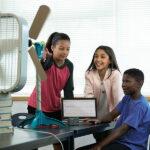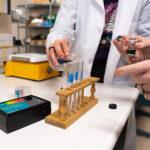
Sharing ideas and inspiration for engagement, inclusion, and excellence in STEM

Proper storage over the summer is key to extending the useful life of your laboratory’s sensors. Before you enjoy your well-deserved summer break, it’s a great idea to take stock of your Vernier probeware and make sure it’s correctly stored for the next few months.
For most of our sensors, this process is relatively simple; they just need to be clean, dry, and (ideally) stored in a temperature-controlled environment. However, some Vernier sensors require a little more TLC.
Getting these sensors ready for summer storage can take a bit of time, but it can ultimately save you time—and money—in the long run. Plus, storing your sensors correctly at the end of this academic year can help set you and your students up for success in the fall.
Here are some best practices for storing your sensors over the summer, as well as some helpful tips for caring for other Vernier technology.
pH and Oxidation-Reduction Potential (ORP) Sensors
Both pH and ORP sensors require wet storage. If these sensors dry out, it requires a lot of effort to revive them, if they can be revived at all. Before storing pH and ORP sensors for an extended period, be sure to inspect the following components:
Both kinds of sensors need to be stored upright or on their side so that the bulb is submerged in the storage solution. For pH sensors, be sure to take a pH reading to make sure the pH is between 3 and 5. If it’s not, check the pH in a freshly prepared buffer solution and then calibrate the sensor.
For more tips about pH sensor care, check out this blog post. You can also watch the video below.
Ion-Selective Electrodes
To get these sensors ready for summer storage, the first step is to check the date printed on the module.
- If it’s older than three years, you will want to replace the module when you’re ready to use the ion-selective electrode.
- If it’s within the last two to three years, simply wet the sponge with about 10 drops of tap water—but do not let the tip of the ion-selective electrode touch the sponge.
The Chloride Ion-Selective Electrode is a special case; it doesn’t have a module, so there is no date to check. To get this sensor ready for summer storage, just clean the tip with the included polishing strips.
Check out the video below to see how you can calibrate a Go Direct® Nitrate Ion-Selective Electrode in our Vernier Graphical Analysis® app.
Oxygen Gas Sensors
The main thing to remember with these sensors is that they must be stored upright. Your best bet is to use the bottle included with your oxygen gas sensor.
In addition, the sensor should read about 20.9 percent. If it doesn’t, calibrate the sensor. This process will differ, depending on whether you have a cabled or Go Direct oxygen gas sensor. You’ll also want to check the voltage (cabled) or relative stability reading (RSR; Go Direct). Ideally, you’re looking for less than 1.8 V or RSR 55.
For dissolved oxygen probes, best practices for summer storage vary based on the model you have. Regular dissolved oxygen probes should be stored dry, but the Go Direct Optical Dissolved Oxygen Probe requires a damp sponge. In either case, the tip of the probe must be completely in a bottle.
Spectrometers and LabQuest®
Our spectrometers and LabQuest interfaces do not require special storage for the summer. The only pro tip is to remove any batteries and store them in a temperature-controlled environment.
And for our spectrometers, if you plan to collect data only via USB, you don’t have to reinstall the battery when classes resume—you need a battery in the device only if you’re collecting data via Bluetooth® wireless technology.
Looking to take a deeper dive into storing your sensors before the school year ends? Check out Summer Sensor Storage: The Ultimate Guide for Giving Your Sensors a Long Life. In this webinar, Colleen McDaniel and I share best practices to help you maintain and store your laboratory’s probeware over the summer.
And if you have questions, we’re happy to help! Contact us at support@vernier.com or 888-837-6437.
Share this Article

Sign up for our newsletter
Stay in the loop! Beyond Measure delivers monthly updates on the latest news, ideas, and STEM resources from Vernier.






